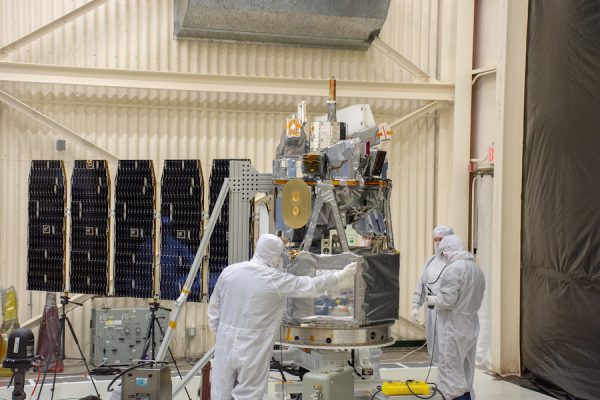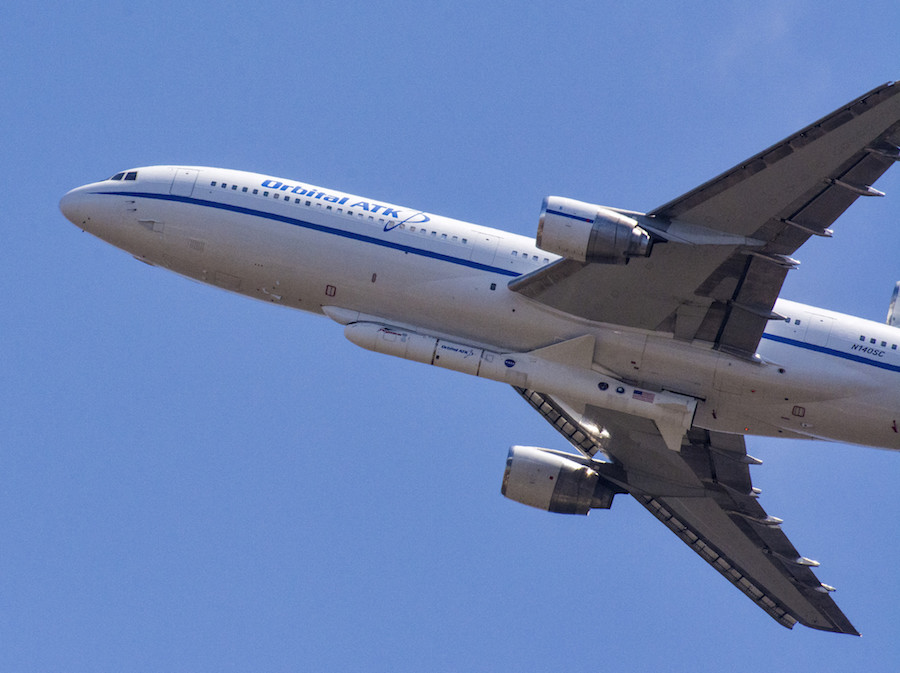Long-delayed NASA science satellite gets October launch date – Spaceflight Now

The launch of a NASA ionospheric research satellite off Florida’s east coast is targeted for Oct. 9 after persistent technical problems with its air-dropped Pegasus rocket stymied two launch opportunities last year.
The launch campaign for the Ionospheric Connection Explorer, or ICON, mission resumed this week.
The first steps were expected to include electrically and mechanically connecting the 634-pound (288-kilogram) ICON spacecraft to the front end of its Northrop Grumman Pegasus XL launcher inside Building 1555 at Vandenberg Air Force Base, California.
In the coming weeks, ground teams inside Building 1555 will encapsulate the satellite inside the Pegasus nose fairing and ready the solid-fueled rocket for rollout to meet an L-1011 carrier jet at the Vandenberg airfield. Technicians will bolt the Pegasus under the belly of the L-1011 jet, which will ferry the rocket on a cross-country flight to Cape Canaveral Air Force Station on Oct. 1, according to NASA.
After final launch rehearsals and checkouts, the L-1011 will take off from the Skid Strip at Cape Canaveral and head to a predetermined drop box over the Atlantic Ocean around 100 miles (160 kilometers) east of Daytona Beach, where the flight crew will release the winged Pegasus launcher to ignite and fire into a 357-mile-high (575-kilometer) orbit with ICON.
The scheduled launch time for ICON is 9:30 p.m. EDT on Oct. 9 (0130 GMT on Oct. 10). NASA previously set the target launch date for Oct. 10, but an earlier date became available on the Air Force-run Eastern Range.
The Pegasus and ICON teams have been through this twice before. Recurring problems in the Pegasus XL’s electrical systems kept the mission grounded on two launch campaigns last year.
Engineers noticed unexpected readings from the Pegasus rocket’s rudder during a ferry flight last June to the mission’s original launch base on Kwajalein Atoll in the Pacific Ocean. Managers decided to return the rocket to Vandenberg during a planned stopover in Hawaii.
NASA and Northrop Grumman officials agreed to relocate the mission’s staging base to Cape Canaveral in the aftermath of the aborted Kwajalein launch campaign. Launching from Florida was not originally planned because the ICON satellite was expected to be slightly heavier than it turned out to be, which would have required a launch from a location closer to the equator.
But similar rudder data signatures cropped up during a ferry flight from Vandenberg to Cape Canaveral last October, prompting more data reviews and hardware changes in an attempt to resolve the problem. Teams thought they might have the issue fixed, but telemetry data again showed a potential problem after the L-1011 and Pegasus departed Cape Canaveral toward the drop box for a launch attempt Nov. 7.
Managers ordered another stand-down to further investigate the problem.
“The launch has been rescheduled to Oct. 10, 2019, following the completion of a joint NASA/Northrop Grumman investigation into a Pegasus sensor reading that was not within normal limits during previous ferry and launch attempt flights,” NASA said in a statement. “The cause of the issue is understood, and the flight hardware has been modified to address the issue.”
NASA said Northrop Grumman conducted two L-1011 test flights with the Pegasus “to verify the effectiveness of the modification.” The test flights revealed no issues.
Sources familiar with the launch preparations said engineers were not able to identify a root cause for the strange readings from the Pegasus rudder actuator, which is located on the rear of the three-stage rocket. Investigators traced the proximate cause of the data problems to the behavior of a potentiometer in a dynamic flight environment.
In addition to the hardware fix, engineers developed new software to filter out “rudder spikes” from poor data, one source said.
“Northrop Grumman thinks they’ve solved the problem,” the source said. “They’ll be monitoring with all eyes on the rudder.”

ICON carries scientific instruments to investigate plasma waves in the ionosphere, a layer in the upper atmosphere where colorful auroras are generated. Changes in the ionosphere can also affect communications and navigation signals coming from satellites, and ICON will study how weather systems lower in the atmosphere can influence conditions at the edge of space.
ICON’s ride into space has been delayed more than two years by concerns related to its Pegasus launcher.
Engineers wanted more time to inspect the Pegasus rocket motors after they were mishandled during shipment to Vandenberg. That pushed the launch back from June to December 2017, the next availability in the military-run range at Kwajalein in the Marshall Islands.
Then managers decided to ground the mission to assess the reliability of bolt-cutters used to jettison the Pegasus rocket’s payload fairing and separate the satellite in orbit.
Those issues were closed out before the first ICON launch campaign last year, when the rudder problems first appeared.
The ICON mission will be the 44th launch of a Pegasus rocket on a satellite delivery mission, and the 34th in the Pegasus XL configuration with uprated solid rocket motors. It will be the seventh Pegasus launch based out of Cape Canaveral, which hosted the most recent Pegasus rocket mission in December 2016.
Northrop Grumman has no more Pegasus launches in its backlog after ICON.
A NASA satellite named the Imaging X-ray Polarimetry Explorer was designed to fly on a Pegasus rocket in 2021 into a unique equator-hugging orbit that would have typically required a launch from an equatorial launch site like Kwajalein, the remote staging point for four previous Pegasus missions, and ICON’s original launch base.
But SpaceX won the IXPE launch contract, and plans to deliver the satellite into its unusual low-inclination orbit using a more powerful Falcon 9 rocket launched from the Kennedy Space Center in Florida.
Another Northrop Grumman customer, Stratolaunch, purchased parts for two Pegasus rockets to launch from the company’s giant carrier aircraft, which flew for the first time in April. But those plans are in doubt after reports that the holding company Vulcan Inc., founded by the late billionaire Paul Allen, is seeking to sell Stratolaunch.
Email the author.
Follow Stephen Clark on Twitter: @StephenClark1.






